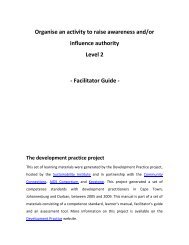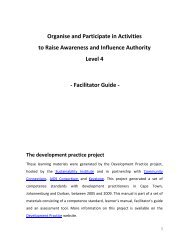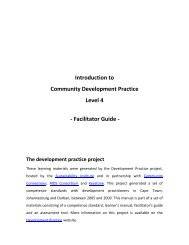the struggle for integrated sustainable settlements.
the struggle for integrated sustainable settlements.
the struggle for integrated sustainable settlements.
You also want an ePaper? Increase the reach of your titles
YUMPU automatically turns print PDFs into web optimized ePapers that Google loves.
Corporatization / Joint Venture<br />
This is a contract in terms of which <strong>the</strong> state gives up limited equity to a private contractor in return <strong>for</strong><br />
one (or a combination) of practical involvements (i.e. from servicing to direct investment).The municipality is<br />
able to structure a unique entity by itself or with <strong>the</strong> private sector. Under this approach defi ned roles and<br />
contributions are agreed and <strong>the</strong> institution implements under a specifi c mandate. This vehicle could fast<br />
track delivery through its narrow and focused mandate. Examples of this could include <strong>the</strong> establishment of<br />
an investment promotion agency, a housing development fund or a development agency that can implement<br />
this strategy <strong>for</strong> a defi ned period on a partnership basis.<br />
Private ownership and operation<br />
In this scenario <strong>the</strong>re is a contract in terms of which <strong>the</strong> state sells all <strong>the</strong> equity to <strong>the</strong> private contractor<br />
subject to specifi ed usage and trading conditions <strong>for</strong> <strong>the</strong> residential facility. The sale of equity can be phased.<br />
In this option <strong>the</strong> municipality can opt to alienate land to <strong>the</strong> private sector <strong>for</strong> development of residential<br />
property in <strong>the</strong> rental and ownership segments of <strong>the</strong> market.<br />
Community-based non-profi t/cooperative institutions<br />
A “community ownership” option, which will <strong>for</strong>m a critical component of a development coalition, rests on<br />
collective savings to generate individual and collective equity that could leverage fur<strong>the</strong>r public and private<br />
funds. A pertinent example of this is <strong>the</strong> savings clubs approach of <strong>the</strong> Federation of <strong>the</strong> Urban Poor (FEDUP).<br />
This option does not stand alone: it can interface with most of <strong>the</strong> o<strong>the</strong>r public and private relationships<br />
referred to above. “Community ownership” means that participants contribute equity which means <strong>the</strong>y<br />
also take risk and <strong>the</strong>re<strong>for</strong>e contribute to <strong>the</strong> protection of <strong>the</strong> asset and its continuous improvement.<br />
Fur<strong>the</strong>rmore, “community ownership” builds bonds of solidarity and reciprocity in <strong>the</strong> community resulting<br />
in a greater sense of community which, in turn, often translates into more reliable repayments, higher levels<br />
of ongoing investment in individual and collective assets, and reduced levels of confl ict, violence and crime.<br />
The institutional arrangements can range from simply savings groups to mobilise community equity and<br />
investment, through to housing associations and even housing cooperatives.<br />
page 26








